Welcome to the SunLife Cost of Dying Report 2025
Welcome to the SunLife Cost of Dying Report 2025
The UK’s longest-running study into the cost of dying and funeral costs over the last 21 years
Both the price of a simple attended funeral and the total cost of dying are now at an all-time high in the UK.
These record-breaking figures come after 21 years of SunLife’s research into funeral prices and trends.
Our industry-leading Cost of Dying Report explores how people are covering mounting funeral costs, changing attitudes towards final farewells, and the evolving landscape facing the industry.
As always, both funeral directors and those who’ve recently organised a send-off have given us plenty of tips and advice on what (and what not) to do.
And for even more insight into funeral costs and trends, download our full PDF report.
How much does a funeral cost in the UK today?
We saw a dip in the cost of a simple attended funeral during the pandemic, but it’s since been on the rise again – now reaching £4,285 (up 3.5% on the previous year), and overtaking 2020’s record price.
The cost of a direct cremation has also increased year on year by almost 7% to £1,597. Both have risen above the rate of inflation over the same period.
Meanwhile, the overall cost of dying – that’s an attended funeral plus professional fees and send-off costs – is also at its highest-ever level of £9,797 (up 1.4%).
Funeral costs
2020 previously marked the highest-ever price of a simple attended funeral. But due to the pandemic (among other things), funeral costs fell in the following two years.
2023 saw the first price rebound, but it’s 2024’s increase of 3.5% that pushes the average to a new all-time high of £4,285. This record-breaking figure comes after 21 years of SunLife’s funeral cost index.
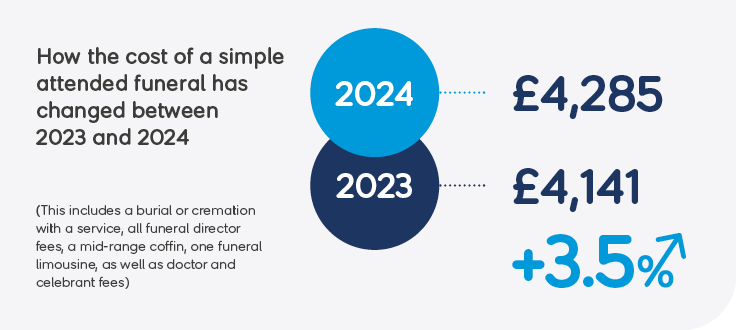
How much does a burial and cremation cost?
Our simple attended funeral cost is a weighted average of attended burials and cremations – taking their separate prices and balancing it by their relative popularity. But we also look into direct cremations and direct burials – the unattended alternatives.
At £1,597, direct cremations are still more affordable than standard burials and cremations. However, after a couple years of falls, their cost is now on the rise – and at a rate higher than all other types of funeral (+6.7%).
For only the second time, we asked people if the funeral they’d organised was a ‘direct burial’. Like a direct cremation, this is a kind of funeral without a service. Instead, the deceased are taken straight to a cemetery and buried – making it a more affordable option.
| Funeral type | 2024 | Change | 2023 |
|---|---|---|---|
| Burial | £5,198 | +2.4% | £5,077 |
| Cremation | £3,980 | +4.9% | £3,795 |
| Direct cremation | £1,597 | +6.7% | £1,498 |
| Direct burial* | £1,527 | -7.8% | £1,657 |
| Average funeral cost | £4,285 | +3.5% | £4,141 |
*Direct burial cost doesn't include third-party fees (such as burial plot).
Funeral costs by UK regions
Like the year before, seven of our 10 UK regions saw average simple attended funeral costs rise in their area in 2024. Only Wales, Yorkshire and the Humber, and South West England saw price drops.
Yet again, Northern Ireland remains the most affordable place to die in the UK, with the average funeral there costing £3,441. And at £5,449, London continues to have the highest price by some margin. That’s a mark-up of 58% from the least to the most expensive region.
Meanwhile, North West England saw the greatest year-on-year increase, of a whopping 13% – leaping from 9th position in 2023 to 4th in 2024. Funeral directors from the region attribute this to rises in crematoria fees and wages.
| Rank | Region | Average funeral cost | Change from previous year |
|---|---|---|---|
| 1 | London | £5,449 | +5.4% |
| 2 | South East & East of England | £4,943 | +6.5% |
| 3 | Scotland | £4,345 | +7.8% |
| 4 | North West England | £4,297 | +13.0% |
| 5 | East & West Midlands | £4,233 | +2.0% |
| 6 | Wales | £4,094 | -4.5% |
| 7 | North East England | £4,047 | +1.9% |
| 8 | Yorkshire and the Humber | £4,031 | -0.8% |
| 9 | South West England | £3,966 | -1.6% |
| 10 | Northern Ireland | £3,441 | +5.7% |
The cost of dying
The ‘cost of dying’ is the total cost of a person’s send-off – including professional fees for administering the estate, a simple funeral service, and all optional extras like the party or wake.
2024 saw the total cost of dying go up by 1.4% to £9,797 – another all-time high. While professional fees have fallen, increases in both funeral and send-off costs mean we’re now paying an average of £139 more than we were in 2023.
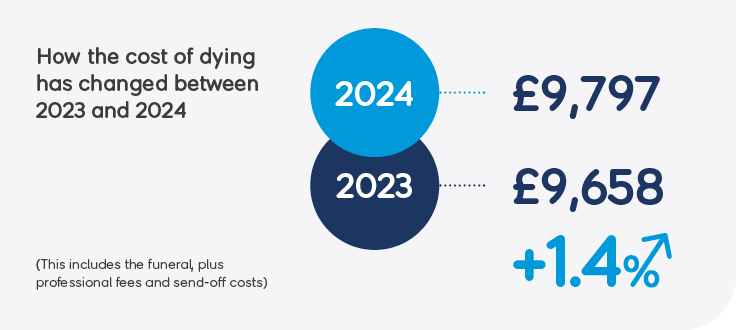
Other costs included in the total cost of dying
Professional fees
After a couple years of sharp rises in professional fees (they went up 6.6% in 2023 and 10.9% in 2022), 2024 saw them decrease by 3.5% to £2,652.
Send-off costs
A send-off is all the optional extras that can make a funeral more personal to the deceased and their loved ones, like the transport, catering, wake, and flowers.
2024 marked another year of rises for send-off costs, now totalling £2,861 – up 3.4%.
The future of funerals
What type of funeral are people choosing?
At 55%, a simple attended cremation with a service is the most popular type of funeral, increasing by 2% on the previous year. In contrast, the percentage of funerals that are burials has gone down by 2% to 25%.
1 in 5 (20%) people describe the funeral they organised as a direct cremation – the same as the year before.
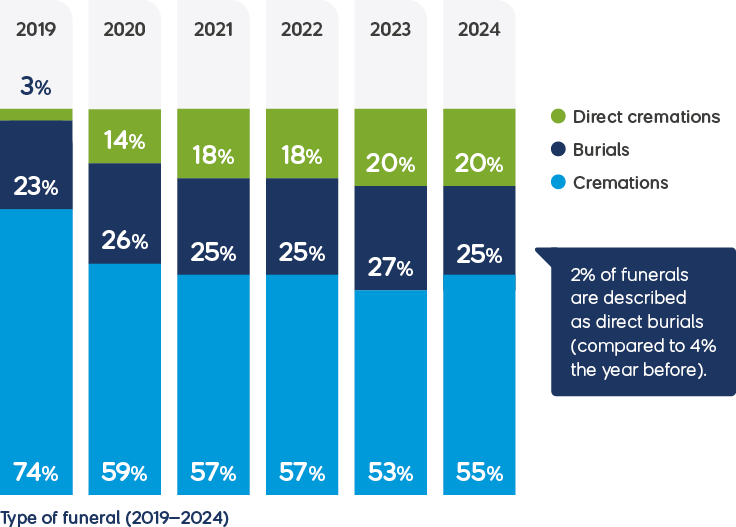
What type of funeral are people choosing?
- 2019. 3% Direct cremations. 23% Burials. 74% Cremations.
- 2020. 14% Direct cremations. 26% Burials. 59% Cremations.
- 2021. 18% Direct cremations. 25% Burials. 57% Cremations.
- 2022. 18% Direct cremations. 25% Burials. 57% Cremations.
- 2023. 20% Direct cremations. 27% Burials. 53% Cremations.
- 2024. 20% Direct cremations. 25% Burials. 55% Cremations.
- 2% of funerals are described as direct burials (compared to 4% the year before).
The continued popularity of direct cremations
The number of direct cremations swelled during the pandemic – out of necessity – but they’ve grown and remained popular even in the years after COVID-19 restrictions. This may in part be down to cost-of-living pressures.
A direct cremation needn’t take place in isolation though. 89% of organisers say they held a small gathering, a wake, a memorial – or a combination of these – beforehand or afterwards.
Paying for a funeral
Who's paying for funerals?
68% of people make provisions specifically to pay for their funeral before they pass away (-2% since 2023).
But only 56% (+2% since 2023) of those put enough aside to cover the whole cost of the funeral.
On top of the deceased’s provisions, many organisers have to fund the funeral through their own or alternative means.
How funerals are being paid for
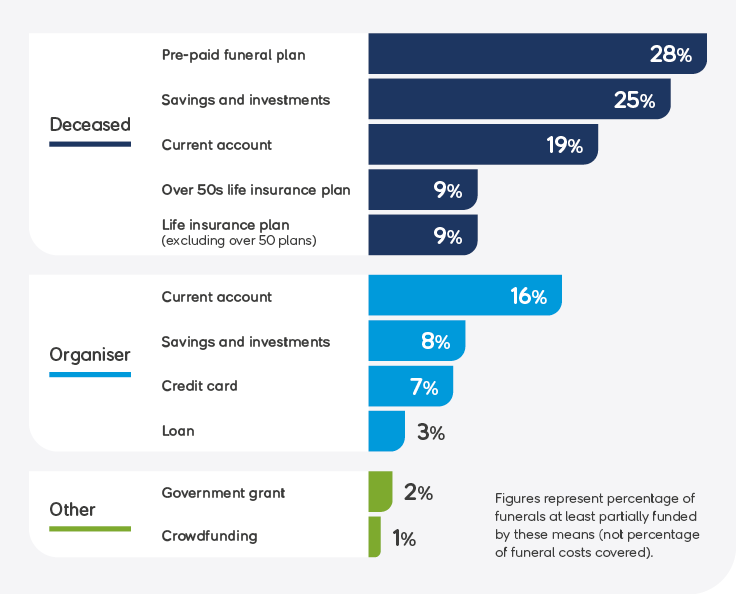
How are loved ones making up the funeral costs?
18% (-2% from 2023) of families experience notable financial concerns when paying for a funeral. On average, they have to find almost £2,371 to cover the costs.
Most of them find the money by delving into their savings and investments (33%), using a credit card (24%), or borrowing from a friend or relative (23%). The number of people selling belongings to cover the cost has risen again, now at 19%.
How people who report notable financial concern make up the funeral cost
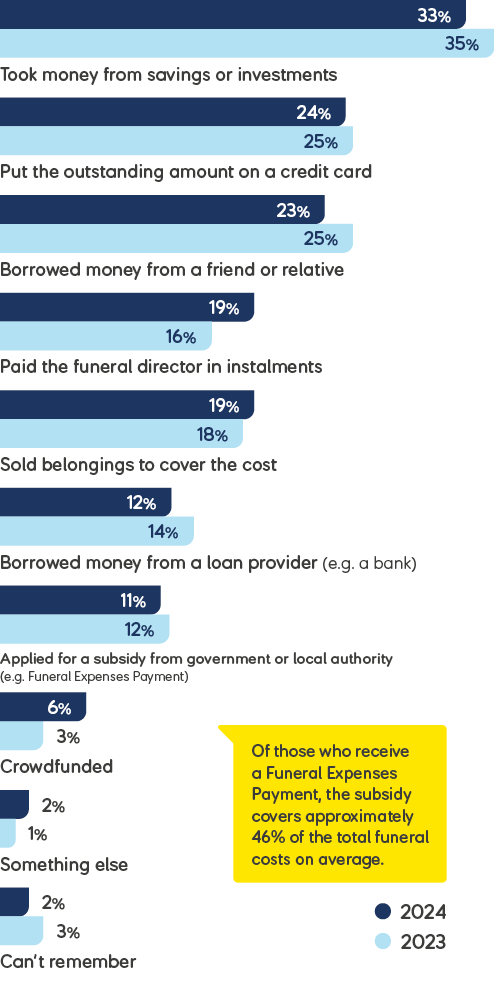
The cost-of-living crisis and the impact of paying for a funeral on our wellbeing
A third (33%) of people say the cost-of-living crisis impacted how they organised and/or paid for the funeral.
And for more than 1 in 5 (22%), paying for a funeral affects their standard of living. 6% struggle to pay essential bills or rent, and 8% have to cut back on essential items such as food.
Of those who experience notable financial difficulties when paying for the funeral, 3 in 4 (75%) report an impact to their mental health. And 60% see an impact to their physical health.
Tips and advice
Cutting costs
With the cost of dying higher than it’s ever been, organisers are looking for ways to keep their spending down. 58% (-1% since 2023) of people report actively cutting back on certain aspects of the funeral to keep costs down.
91% of funeral directors say people spend more money than they need to, on things such as catering and the coffin. A massive 75% of those mention flowers in particular.
How do people cut costs?
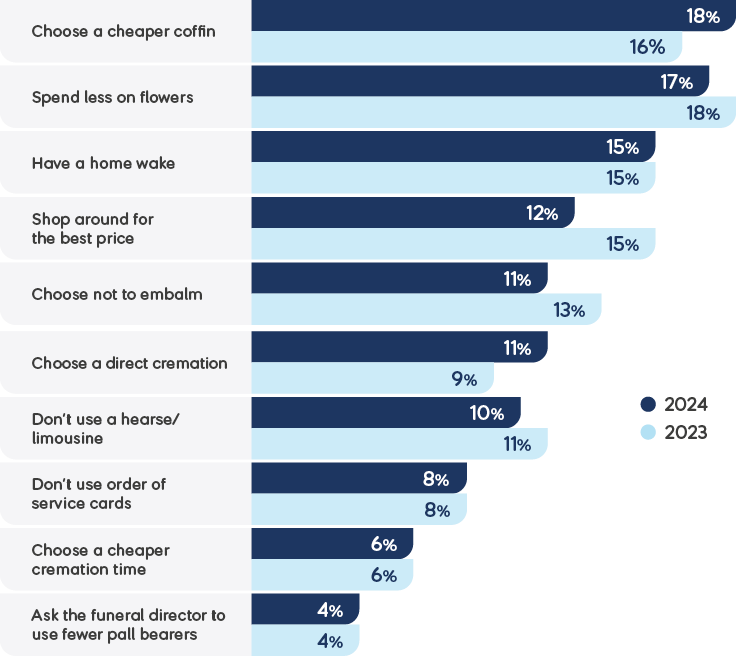
Planning a funeral
Planning a funeral can be difficult. Here are some tips on how to give your loved ones a special send-off while keeping the stress down…
Advice from funeral organisers
- A funeral doesn’t need to be expensive – it’s no reflection on the deceased’s life
- Take your time
- Delegate separate tasks to close family members so they know they had a part
- Look for reviews on funeral directors
Advice from funeral directors
- Speak to different companies and see what they can offer
- Be comfortable with the funeral director you’re using
- Ask for information and as many questions as you want
- Make sure you’re certain of what the deceased wanted as it can lead to arguments
Funeral wishes
Let's talk about funeral wishes
Brits still don’t like talking about death and funerals.
Over half (51%) don’t even know if their loved one wanted a burial or cremation – although that’s 3% less than in 2023.
Once again, 1 in 5 (18%, down 1% since 2023) don’t know any of their loved one’s funeral wishes. And less than 1% know all their loved one’s funeral wishes.
What do organisers know about their loved one's funeral wishes?
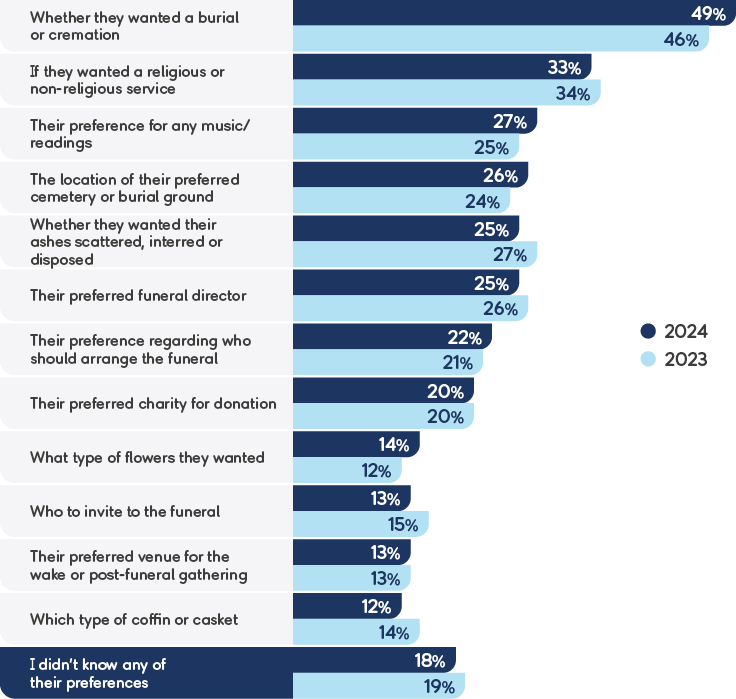
Are we planning ahead?
Despite the fact that we’re still not talking about funerals much, organising one prompts 65% to start thinking about their own funeral (down 1% since 2023).
The number of people who’ve made a will has risen to 28% (+4%) since the previous year, while those who’ve spoken to someone about their preferences has stayed at 26%.
The number of people who haven’t made any of their wishes known yet is also the same as the year before at 21%. So there’s still work to be done when it comes to keeping our loved ones in the loop.
How people who have arranged a funeral are planning for their own
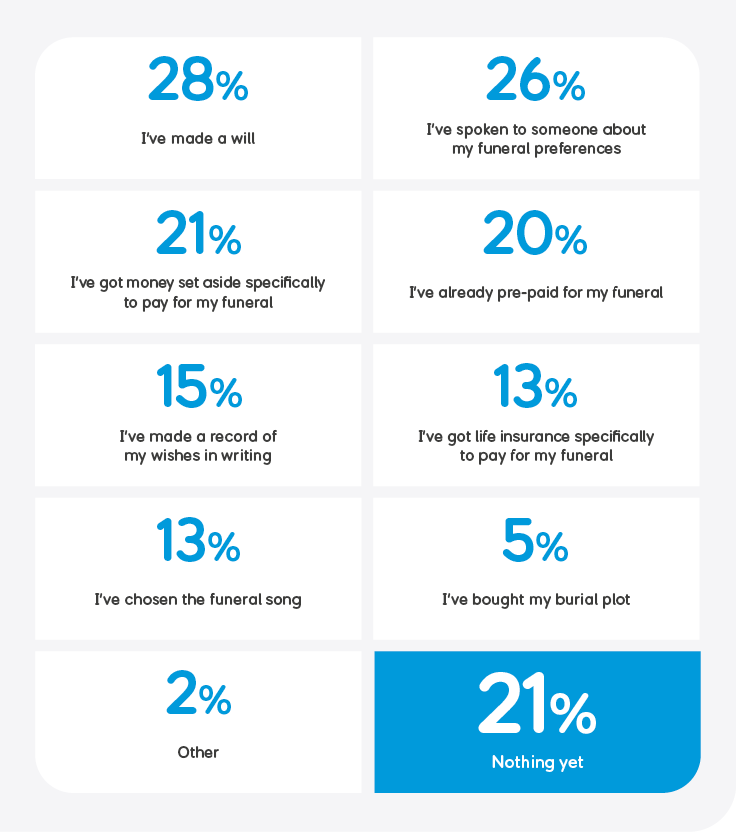
The data is as follows:
- 28% Ive made a will
- 26% I've spoken to someone about my funeral preferences
- 21% I've got money set aside specifically to pay for my funeral
- 20% I've already pre-paid for my funeral
- 15% I've made a record of my wishes in writing
- 13% I've got life insurance specifically to pay for my funeral
- 13% I've chosen the funeral song
- 5% I've bought my burial plot
- 2% Other
- 21% Nothing yet
Trends and traditions
Attitudes have shifted
As in recent years, half of all funeral services (51%, up 1% since 2023) are described as a celebration of life, according to those who organised them.
However, this figure is up significantly from 31% when we first reported on celebrations of life in 2017. And 79% (+2%) of funeral directors say they’ve seen a rise in the number of these funerals.
How organisers describe the tone of the funeral service

What trends are funeral directors seeing?
9 in 10 (91%) funeral directors say they’ve seen trends or changes in the funerals that they’re organising (-1% since 2023).
In 2023, the most common trend they mentioned was the use of social media to invite people to the funeral. But now the top trend is people sharing video links and apps so that non-attendees can watch remotely.
The number of directors who name this as the most common new trend has risen from 31% to 44%.
What changes are funeral directors seeing?
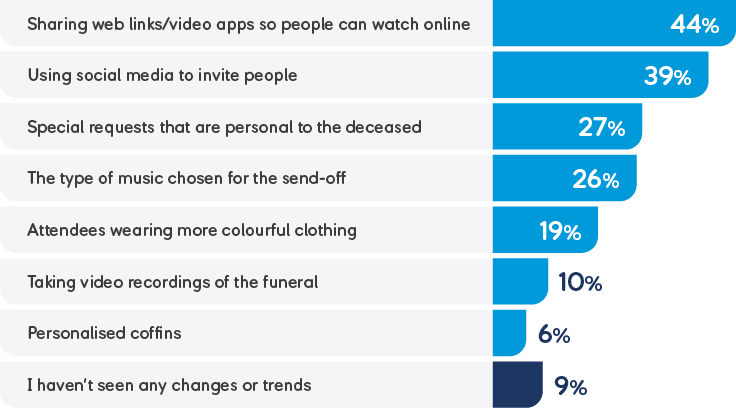
What are we doing with our loved one's ashes?
Over half (51%) of funeral organisers have scattered their loved one’s ashes or will be scattering them (+4% since 2023).
Over a quarter (27%, -3% since 2023) keep the ashes, and one fifth (20%) bury them.
The most popular place to scatter a loved one’s ashes is still in a garden of remembrance (30%, -1%). 15% of people choose the beach, while over 1 in 10 choose at sea, a woodland, or a river or lake. And like the year before, 2% say they scattered the ashes at a sports venue.
Where ashes are being scattered
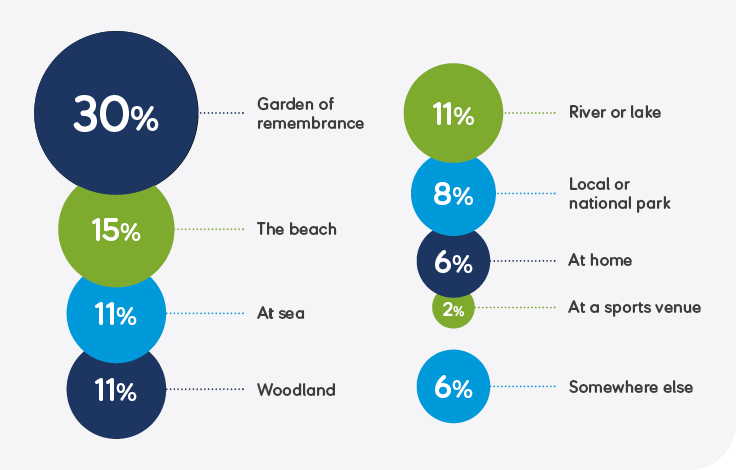
The data is as follows:
- 30% Garden of remembrance
- 15% The beach
- 11% At sea
- 11% Woodland
- 11% River or lake
- 8% Local or national park
- 6% At home
- 2% At a sports venue
- 6% Somewhere else
The nation's favourite funeral songs
An easy way to make a funeral service more personal is to choose songs that mean something to you and your loved ones.
Frank Sinatra’s ‘My Way’ is the most played funeral song, overtaking the hymn ‘Abide With Me’. And like the year before, it’s still the most popular choice when choosing a song for our own funeral.
The future of the funeral industry
Regulation of the funeral industry
In 2021, the Competition and Markets Authority (CMA) ordered funeral directors and crematorium operators to make prices clear for customers or risk court action.
Like the previous year, 61% of funeral directors think the funeral industry has improved as a result of the new CMA order.
Have the introduction of regulations improved the funeral industry?

The data is as follows:
- 25% Improved a lot
- 36% Improved a little
- 30% No difference
- 1% Worsened a little
- 1% Worsened a lot
- 6% Don't know
What are the challenges facing the funeral industry?
Today, funeral directors are most worried about:
- Loss of trust following the funeral home scandal in Hull in March 2024
- Rising funeral costs, and families that aren’t able or don’t want to pay
- Increased competition from direct cremation providers, especially those online
Find out more about funeral planning
Our collection of funeral planning articles can help with arranging a loved one’s send-off, getting your own affairs in order, or supporting someone at a difficult time. Plus our tools are perfect for thinking about and recording what you’d like once you’re gone:
Download the latest report
For even more insight into current funeral costs and trends, download our latest report.
We’ve been tracking funeral costs since 2004 at SunLife. If you need any past reports – or have any questions about this one – please email our press office.
